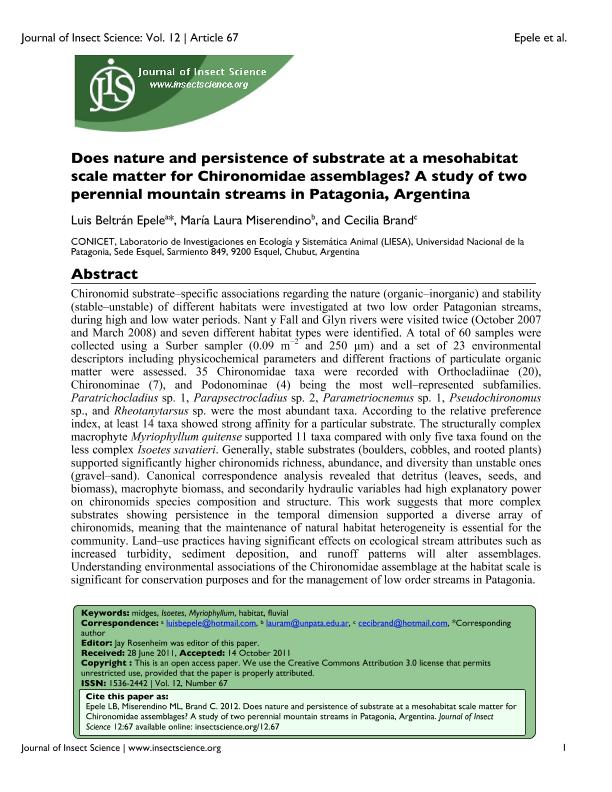Mostrar el registro sencillo del ítem
dc.contributor.author
Epele, Luis Beltran

dc.contributor.author
Miserendino, Maria Laura

dc.contributor.author
Brand, Cecilia

dc.date.available
2016-12-14T19:16:56Z
dc.date.issued
2012-05
dc.identifier.citation
Epele, Luis Beltran; Miserendino, Maria Laura; Brand, Cecilia; Does the nature and persistence of a substrate at a mesohabitat scale matter for Chironomidae assemblages? A study in two perennial mountain streams in Patagonia, Argentina; University Of Arizona; Journal Of Insect Science; 12; 5-2012; 1-19
dc.identifier.issn
1536-2442
dc.identifier.uri
http://hdl.handle.net/11336/9428
dc.description.abstract
Chironomid substrate-specific associations regarding the nature (organic-inorganic) and stability (stable-unstable) of different habitats were investigated at two low order Patagonian streams, during high and low water periods. Nant y Fall and Glyn rivers were visited twice (October 2007 and March 2008) and seven different habitat types were identified. A total of 60 samples were collected using a Surber sampler (0.09 m-2 and 250 μm) and a set of 23 environmental descriptors including physicochemical parameters and different fractions of particulate organic matter were assessed. Thirty five Chironomidae taxa were recorded with Orthocladiinae (20), Chironominae (7) and Podonominae (4) being the best represented subfamilies. Paratrichocladius sp. 1, Parapsetrocladius sp. 2, Parametriocnemus sp. 1., Pseudochironomus sp. and Rheotanytarsus sp. were the most abundant taxa. According to the Relative Preference Index at least 14 taxa showed strong affinity for a particular substrate. The structurally complex macrophyte Myriophyllum quitense supported 11 taxa compared with only 5 taxa found on the less complex Isoetes savatieri. Generally, stable substrates (boulders, cobbles and rooted plants) supported significantly higher chironomids richness, abundance and diversity than unstable ones (gravel-sand). Canonical Correspondence Analysis revealed that detritus (leaves, seeds biomass), macrophyte biomass, and secondarily hydraulic variables had high explanatory power on chironomids species composition and structure. This work suggest that more complex substrates showing persistence in the temporal dimension supported a diverse array of chironomids, meaning that the maintenance of the natural habitat heterogeneity is essential for the community. Land-use practices having significant effects on ecological stream attributes such as turbidity, sediment deposition, runoff patterns, will alter assemblages. Understanding environmental associations of the Chironomidae community at the habitat scale is significant for conservation purposes and for the management of low order streams in Patagonia.
dc.format
application/pdf
dc.language.iso
eng
dc.publisher
University Of Arizona

dc.rights
info:eu-repo/semantics/openAccess
dc.rights.uri
https://creativecommons.org/licenses/by-nc-sa/2.5/ar/
dc.subject
Midges
dc.subject
Isoetes
dc.subject
Myriophyllum
dc.subject
Habitat
dc.subject
Fluvial
dc.subject.classification
Conservación de la Biodiversidad

dc.subject.classification
Ciencias Biológicas

dc.subject.classification
CIENCIAS NATURALES Y EXACTAS

dc.subject.classification
Ecología

dc.subject.classification
Ciencias Biológicas

dc.subject.classification
CIENCIAS NATURALES Y EXACTAS

dc.title
Does the nature and persistence of a substrate at a mesohabitat scale matter for Chironomidae assemblages? A study in two perennial mountain streams in Patagonia, Argentina
dc.type
info:eu-repo/semantics/article
dc.type
info:ar-repo/semantics/artículo
dc.type
info:eu-repo/semantics/publishedVersion
dc.date.updated
2016-11-17T16:03:44Z
dc.journal.volume
12
dc.journal.pagination
1-19
dc.journal.pais
Estados Unidos

dc.journal.ciudad
Arizona
dc.description.fil
Fil: Epele, Luis Beltran. Universidad Nacional de la Patagonia Austral; Argentina. Consejo Nacional de Investigaciones Científicas y Técnicas. Centro Nacional Patagónico; Argentina
dc.description.fil
Fil: Miserendino, Maria Laura. Universidad Nacional de la Patagonia Austral; Argentina. Consejo Nacional de Investigaciones Científicas y Técnicas. Centro Nacional Patagónico; Argentina
dc.description.fil
Fil: Brand, Cecilia. Universidad Nacional de la Patagonia Austral; Argentina. Consejo Nacional de Investigaciones Científicas y Técnicas. Centro Nacional Patagónico; Argentina
dc.journal.title
Journal Of Insect Science

dc.relation.alternativeid
info:eu-repo/semantics/altIdentifier/doi/http://dx.doi.org/10.1673/031.012.6801
dc.relation.alternativeid
info:eu-repo/semantics/altIdentifier/url/http://jinsectscience.oxfordjournals.org/content/12/1/68
Archivos asociados
